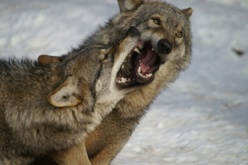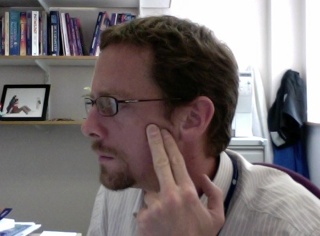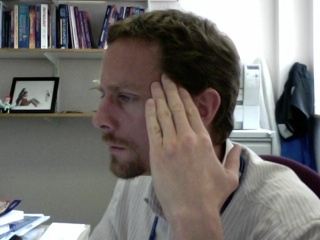
In my anatomy session this week we started looking at the anatomy of the head (as I may have mentioned several times, probably my favourite area, anatomically-speaking). In this station, we looked at the movements of the jaw, the muscles that make those movements, some of the bones involved (bones of the skull – get looking at skulls now because this is crucial for this term) and found that we were looking at the infratemporal fossa. We described what this was and noted a number of important structures passing through it.
So what are the movements of the mandible? The temporomandibular joint (TMJ), between the temporal bone and the condylar process of the mandible, allows for some interesting movements, and the left and right TMJs work together to allow us to bite, chew and express ourselves. It isn’t a particularly standard synovial joint structurally, histologically, or in the way that it articulates. Opening the mouth involves both the hinging of these joints and the forward translocation of the mandible out from the joint cavity.
Back to movements. We can elevate the jaw, depress it, move it from side to side, protrude it, and retract it. Combining these movements and making slightly different movements on either side allows us to get to grips with our food and chew it. There is a great deal of power exerted through our teeth when we bite. So what muscles give what movements? We can feel the masseter muscle getting thicker as it contracts if we palpate the region just anterior to our ears when we clench our jaws (yes, do it now). The masseter muscle is a superficial muscle attached to the zygomatic arch and to the ramus and angle of the mandible.
We can also palpate the temporalis muscle (touch your “temples”, or temporal region) when we clench our jaws. This is another superficial muscle but has a broad, curving attachment to the bones that it covers (frontal, parietal and temporal bones). Its fibres all come together to pass deep to the zygomatic arch and insert into the coronoid process of the mandible, giving it not only great power from its size but also a mechanical advantage relative to the pivot point of the TMJ. This is a really powerful biting (or mandible elevating) muscle. It’s really, really powerful and much larger in animals that need to rip other animals apart with their teeth.
So if the temporalis muscle is a major elevator of the jaw, the masseter aids this movement, but is also involved in the side to side movement. There are two more muscles of mastication, and both are deep to the mandible. The medial and lateral pterygoid muscles both attach to the lateral plate of the pterygoid process of the sphenoid bone. You can see what this is here on Wikipedia, but you really need to go to the lab and pick up a skull to get the best feel for where it is.
The lateral pterygoid muscle is rather different to the other muscles of mastication as its fibres run horizontally. All the other muscles run in almost vertical directions, but the horizontal fibres of the lateral pterygoid muscle are able to protract the jaw. The sphenoid bone doesn’t move, the fibres of the lateral pterygoid muscle contract, and they pull the head of the mandible anteriorly in the TMJ.
The medial pterygoid muscle runs inferiorly from the pterygoid process down to the deep surface of the mandible, on the other side of the mandible from the masseter muscle. This muscle also helps elevate the mandible.
What causes depression? I mean, what muscles depress the mandible? Gravity has a role here, but the strap muscles in the anterior neck (digastric, geniohyoid, mylohyoid) are able to pull the mandible down. The masseter and temporalis muscles are able to retract a protruded jaw, by the way.
By looking at the pterygoid plates and the muscles there, we’ve put ourselves into the infratemporal fossa. What’s that then? Well, I’m a bit worn from writing all that so I’ll write up the infratemporal fossa stuff a bit later.
Where to poke?

Palpating the masseter muscle.

Palpating the temporalis muscle.